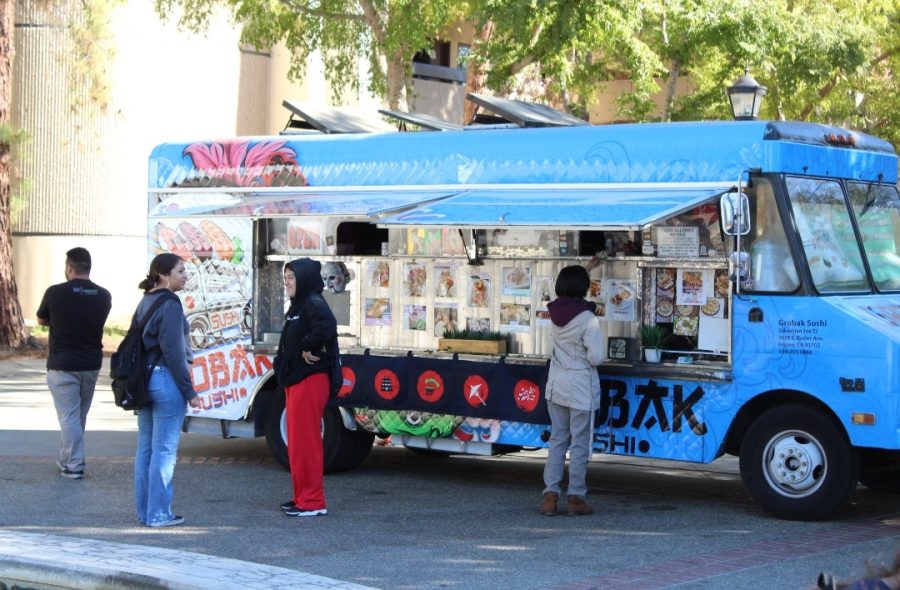“36 Views,” Fresno City College Theatre’s first production of the year, is directed by Chuck Erven, and the production runs Oct. 8-16. Written by Japanese American playwright, Naomi Iizuka, the play is a complex story focusing on different perceptions of truth.
The play takes its name from “36 Views of Mount Fuji,” a series of prints by Hokusai, a Japanese artist known for his blending of Japanese and Western styles. Each print presents a different vignette of Japanese landscapes, implying that despite each scene having a unique lifestyles, all are bound by their connection to Mount Fuji.
The play melds Asian and American concepts, utilizing many aspects of Japanese Kabuki theatre throughout.
With a wooden flute, drums and clappers, two onstage musicians add to the drama taking place and punctuate the atmosphere to change the scenes from a Heian-era Japanese court to an art gallery in an unnamed modern American city.
Set designer Chris Bolt said, “I picture it being set in Manhattan. We know it’s in a major city; I really think it’s Manhattan, but there’s an east meets west.”
The opening scenes work quickly to highlight the characters’ unique cultural and technical specialties and the play’s philosophical themes about the subjective nature of truth. On the surface, the topics seem to be esoteric, but the dialogue effectively explains the jargon and concepts in an accessible way, similar to popular crime TV shows such as “CSI.”
“She’s written the play cinematographically … There’s short, voyeuristic views into what the characters are thinking. Its not like we have an opening prologue that tells you everything about the play. As you continue watching, every scene gives you clues to where the play is going,” said costume designer, Debra Shapazian.
The play opens as Darius Wheeler (Garret Putnam), an American art dealer specializing in Asian art, with a flexible definition of “authentic,” telling a “true story” during a gallery showing for a well known contemporary Asian artist.
Wheeler and his assistant, John Bell (Jono Cata), are hosting the show. Bell holds multiple Masters Degrees, is fluent in a variety of Asian languages, has written several incomplete books, and carries a deep respect for Wheeler bordering on hero worship. His guests include Claire Tsong (Jo Smith), a successful mixed media artist who works for Wheeler as an independent contractor restoring damaged antiques.
Elsewhere, Wheeler discusses the nature of beauty in art with Owen Mathiassen (Matt Venezia), the chair of the East Asian Studies Department, and Setsuko Hearn (Kari Cowell) an assistant professor of East Asian Studies. Throughout the night, Elizabeth Newman Orr (Bridget Manders) attempts to get Wheeler’s attention for a business deal requiring Wheeler to facilitate an “honest” transaction.
The plot develops when Wheeler finds Bell’s manuscripts for a pillow book, a poetic diary kept by an 11th century noble women during Japan’s Heian era.
Recognizing the book to be “authentic,” the characters are brought together by the potential the book represents to each of them, whether as a new revolutionary insight into their academic field or a fantastic business opportunity. Each subsequent scene reveals relationships that are at times only slightly more “authentic” than the book.
Audrey Brennan, the production’s stage manager, said, “The playwright likes to write impossible plays. She will write in things that seem impossible like floating images or Bukari costume changes which involve pulling a thread and the entire costume changes. Her entire approach to play writing is to make someone do the impossible.”
Through the application of more than still and video projections, live and pre-recorded audio, on-stage costume changes, and mechanical set changes, the play meets the challenge.
Hikinuki; a Kabuki theatre technique of synchronizing dance with a costume change, helps the characters flow from a Heian-era to modern roles.
Erven makes heavy use of visual effects, using over 120 projections over the course of the two-hour production.
“That’s one of the biggest challenges in theatre. Every show you do is a brand new show, and you have no idea how you’re going to do any of it,” said Boltz, “There’s nothing easy; it’s all custom built. It’s all special.”



